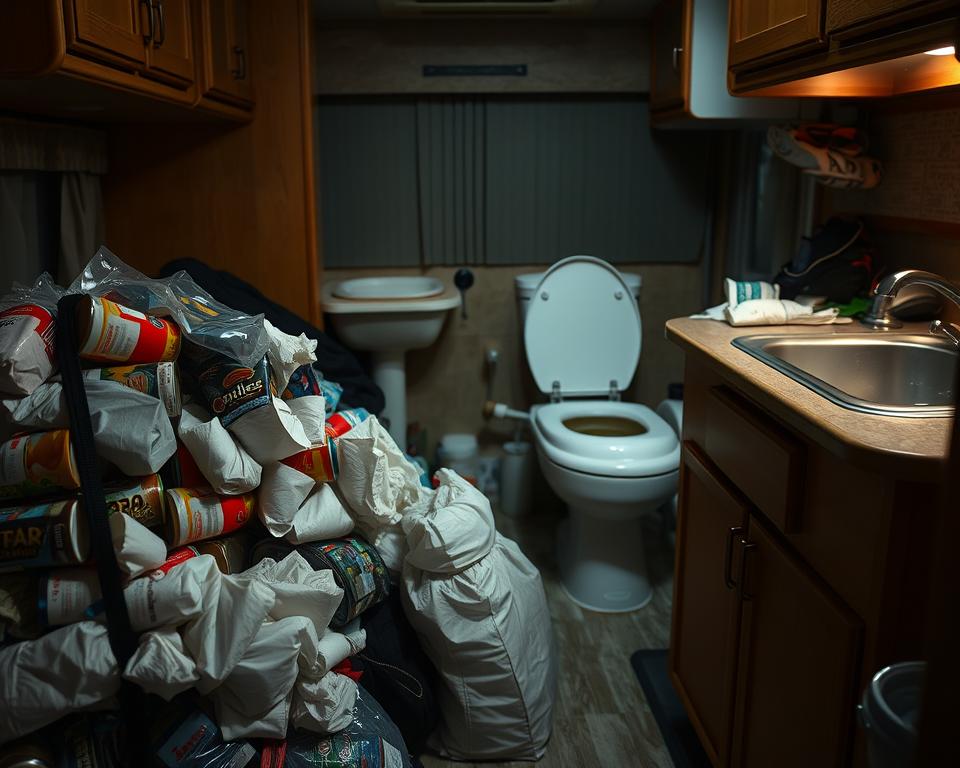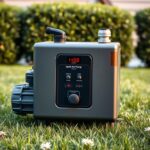RV Septic Tank Pumping: Essential Maintenance Tips
Imagine what happens when you ignore your RV’s sewer setup. A lot of motorhome owners dread tank emptying. Yet, realizing the importance of these maintenance practices is vital. These steps preserve your camping joy and avoid expensive repairs. Mastering correct waste handling is fundamental to your system’s longevity. We’ll share vital insights on RV pumping service, including best practices and tips to keep your system running smoothly.
The Basics of Your RV Sewage System
Every recreational vehicle features a septic setup. It consists of a black tank for toilet use, a gray tank for sinks/showers, plus a freshwater reservoir. Grasping how each part works is key to proper black tank servicing and overall system care.
Drains and vents manage liquid and air movement throughout the system. Understanding this synergy helps you avoid blockages and buildup. This knowledge ensures hassle-free trips and reliable waste handling.
Regular checks and care keep your tanks in top shape. Monitoring fill levels and dumping when needed keeps odors at bay. Proper upkeep extends tank life and enhances every journey.
The Value of Consistent Septic Maintenance
Routine sewage draining preserves functionality and hygiene. Leftover solids lead to smells and clogs, spoiling your trip. A full tank can produce embarrassing backups. Such mishaps kill the fun on the road.
Skipping pump-outs leads to pricey repairs. Damage from neglect can shorten component lifespan. Timely emptying keeps your plumbing running smoothly. It prevents unwelcome surprises and roadside emergencies.
Proactive servicing stops clogs. Dedicating effort to pumping reflects good RV stewardship. It greatly improves your travel experience. A strict pumping routine lets you enjoy camping without septic concerns.
Finding the Right Dump Frequency
Determining dump intervals needs careful thought. Generally, dump every 3–5 days when in use. Still, it varies with tank size and occupancy. Pinpointing the correct dump time is key for effective wastewater management.
Empty once the black tank reaches roughly 66% full. It ensures good drainage and cuts down on odors. Ignoring it can cause backups and unpleasant odors.
Many elements can affect how often you pump:
- Number of people on board
- Length of stay
- Type of waste generated
- Tank capacity
Planning is key to avoiding emergencies. Sync with any public dump station hours. Tracking your usage helps forecast dump needs.
| Usage Scenario | Pumping Frequency |
|---|---|
| Weekend Getaway (2 people) | Every 3–4 days |
| Long Stay, Four to Six Occupants | Every 2–3 days |
| Seasonal Living (2–4 people) | Weekly or Bi-Weekly |
Monitor fill levels and usage patterns. This proactive stance ensures enjoyable travel.

Proper Tank Dumping Techniques
Proper methods stop odors, clogs, and expensive repairs. Begin with the black tank to avoid cross-contamination. This prevents dirty water from fouling the clean.
A sturdy sewer hose reduces spill chances and aids flow. Tighten connections to stop spills. Once both tanks are clear, rinse the black tank thoroughly. This removes residue and preps the tank for next time.
Know where dump stations are located. Being prepared saves time on the road.
In short, follow these key steps for efficient dumping:
- Empty the black water tank first.
- Use a top-quality sewer hose.
- Flush the black tank thoroughly after emptying.
- Plan your dump station locations.
Following these guidelines simplifies black tank maintenance.
Tank Handling and Upkeep Best Practices
Grasping correct handling of black and gray tanks ensures system health. Maintain a bit of water in the black tank to aid waste decomposition.
Don’t flush wipes, feminine products, or paper towels. Always use RV-safe toilet paper to prevent clogs. Regular checks spot leaks or cracks before they worsen.
Adding treatments now and then improves septic service. They introduce microbes that digest solids effectively. Simple steps ensure smooth tank operation.
- Check for leaks and damage often.
- Apply RV-specific chemical treatments.
- Keep vents clear to avoid odors.
Adhering to these practices safeguards your system. You’ll enjoy more worry-free trips.
How to Pump Efficiently
Successful pumping requires precision and a clear procedure. Proper disposal prevents issues—only dump at approved stations. Understanding volume limits prevents spills on the go.
Check tank indicators regularly to time pump-outs. Routine scheduling preserves your septic system and travel enjoyment. Setting a dumping schedule improves system efficiency.
Flush well after every emptying. It ensures each dump is cleaner than the last. By applying these strategies, you’ll maintain your RV’s condition and comfort.
Common Mistakes to Avoid When Maintaining Your RV Septic System
Maintaining your system is vital for uninterrupted camping. Not using enough water in the black tank leads to buildup. Proper flushing dissolves waste better.
Flushing inappropriate items blocks pipes. Avoid non-dissolvable products like feminine hygiene items. They cause backups and costly service calls.
Leaving the black valve open too early is a mistake. Premature opening prevents a full flush. Only open when ready to empty for a complete clean.
Awareness of these errors boosts system longevity. Avoiding them keeps your waste management reliable.
When to Call in Professional RV Waste Disposal Services
Knowing when to hire pros preserves system health. Lingering smells can mean serious tank problems. Slow drains point to potential clogs or buildup.
Visible residue at dump points requires attention. It often calls for a deep professional clean. Pros blast away blockages to restore smooth flow.
Regular expert check-ups safeguard tank health. Early intervention avoids expensive failures. Professional service ensures proper functionality.
Sustainable Waste Management Strategies
Long-term strategies sustain wastewater efficiency. Regular pumping boosts system life and function. Flushing often prevents buildup and costly repairs.
Implementing clean cycles safeguards tank health. Inspecting connections stops leaks before they spread. Choosing eco-friendly treatments avoids damage.
Keep these habits in mind:
- Stick to a pump-out timetable.
- Rinse often to remove solids.
- Sanitize twice a year.
- Inspect parts frequently for wear and tear.
Proactive care delivers worry-free travel. Routine service lets you focus on the scenery, not your sewer.
To Conclude
Effective RV septic maintenance is crucial for a pleasant experience. Understanding operation and following guidelines prevents headaches. Regular black tank maintenance improves efficiency. It enhances every mile.
By regularly checking and properly caring for your septic setup, you’ll ensure worry-free travel. This reliability supports every outing. These routines prime your rig for future rides. Thus, you can concentrate on adventures rather than septic concerns.

